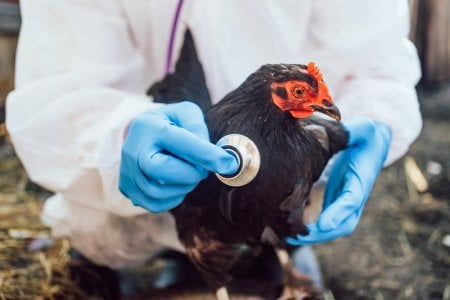Is Australia's effort too little to prevent this massive extinction? Advocacy group shares ‘pathetic’ detail
By
Seia Ibanez
- Replies 13
Australia is renowned for its unique and diverse wildlife, but this natural heritage is under threat like never before.
As spring approaches, conservationists are sounding the alarm about a potential mass extinction event, and the federal government's response is being criticised as insufficient.
The looming threat? A highly pathogenic avian influenza that has already wreaked havoc across the globe, decimating bird and mammal populations on every continent, including Antarctica.
The Invasive Species Council, a leading advocacy group, has expressed concern over the government's slow response to this impending crisis.
While acknowledging that the issue is now being taken seriously, the council has highlighted that only $580,000 has been specifically allocated to protect wildlife—a sum they deem 'pretty pathetic’.
The missed opportunity to secure more substantial funding in the May budget means Australia may be ill-prepared for the virus's expected arrival with migratory birds this spring.

Jack Gough, a spokesperson for the council, didn't mince words: 'The problem is they’ve been caught with their pants down, and now they’re scrambling to respond. And we’re pleased that they are, but if it turns up this spring we are not prepared.'
The potential impact of the avian flu on Australia's wildlife could be devastating. Dr Michelle Wille, a microbiology expert from the University of Melbourne, warned at a national forum that the arrival of the deadly HPAI H5N1 strain could be 'catastrophic’.
‘It’s going to rock up, and it’s going to cause massive widespread deaths with very large outbreaks and lots of dead animals on the landscape,’ she said.
Her 2023 study found that the virus had impacted 356 species, and the number is likely higher now. In Peru, for example, around 40 per cent of pelicans died within two months.
The virus has also jumped to mammals, affecting over 50 species. In the United States, the infection of field mice by HPAI was considered 'unheard of’, and in South America, tens of thousands of sea lions and elephant seals have perished.
Australia's own sea lion population, along with all water-associated birds such as penguins, swans, and ducks, are expected to be highly threatened.
If the virus becomes established, it could spread to other native birds and mammals, exacerbating the risk of extinction.
The Invasive Species Council's Gough criticised what he saw as a 'persistent fatalism' within the government.
‘The focus seems to be on managing how people will respond to seeing dead birds, managing the potential human health risks, but not on what is needed to reduce deaths and make sure species don’t go extinct,’ he said.
‘The problem we have is that there’s no significant money dedicated to this, and that’s a huge barrier to proper preparedness they seem to be scrambling, and everything is done on the fly, and birds could be turning up this month, and that’s a problem.’
He urged the government to develop urgent plans to safeguard iconic sites like Kakadu National Park, Ramsar wetlands, and islands such as Lord Howe, Christmas, and Kangaroo.
In response to these concerns, the government has established an HPAI Preparedness Taskforce, which includes members from various departments and agencies.
‘The taskforce is working closely with state and territory agencies, Wildlife Health Australia, Animal Health Australia, wildlife experts, industry, NGOs and community groups to coordinate national preparedness efforts and investments. This is to ensure a whole-of-government and one health approach to this cross-sectoral disease threat,’ the Environment Department said.

What are your thoughts on this developing situation? How do you protect yourself from potential health risks? Share your opinions and suggestions in the comments below.
As spring approaches, conservationists are sounding the alarm about a potential mass extinction event, and the federal government's response is being criticised as insufficient.
The looming threat? A highly pathogenic avian influenza that has already wreaked havoc across the globe, decimating bird and mammal populations on every continent, including Antarctica.
The Invasive Species Council, a leading advocacy group, has expressed concern over the government's slow response to this impending crisis.
While acknowledging that the issue is now being taken seriously, the council has highlighted that only $580,000 has been specifically allocated to protect wildlife—a sum they deem 'pretty pathetic’.
The missed opportunity to secure more substantial funding in the May budget means Australia may be ill-prepared for the virus's expected arrival with migratory birds this spring.

Invasive Species Council shared a ‘pretty pathetic’ detail in combatting the avian influenza. Credit: Shutterstock
Jack Gough, a spokesperson for the council, didn't mince words: 'The problem is they’ve been caught with their pants down, and now they’re scrambling to respond. And we’re pleased that they are, but if it turns up this spring we are not prepared.'
The potential impact of the avian flu on Australia's wildlife could be devastating. Dr Michelle Wille, a microbiology expert from the University of Melbourne, warned at a national forum that the arrival of the deadly HPAI H5N1 strain could be 'catastrophic’.
‘It’s going to rock up, and it’s going to cause massive widespread deaths with very large outbreaks and lots of dead animals on the landscape,’ she said.
Her 2023 study found that the virus had impacted 356 species, and the number is likely higher now. In Peru, for example, around 40 per cent of pelicans died within two months.
The virus has also jumped to mammals, affecting over 50 species. In the United States, the infection of field mice by HPAI was considered 'unheard of’, and in South America, tens of thousands of sea lions and elephant seals have perished.
Australia's own sea lion population, along with all water-associated birds such as penguins, swans, and ducks, are expected to be highly threatened.
If the virus becomes established, it could spread to other native birds and mammals, exacerbating the risk of extinction.
The Invasive Species Council's Gough criticised what he saw as a 'persistent fatalism' within the government.
‘The focus seems to be on managing how people will respond to seeing dead birds, managing the potential human health risks, but not on what is needed to reduce deaths and make sure species don’t go extinct,’ he said.
‘The problem we have is that there’s no significant money dedicated to this, and that’s a huge barrier to proper preparedness they seem to be scrambling, and everything is done on the fly, and birds could be turning up this month, and that’s a problem.’
He urged the government to develop urgent plans to safeguard iconic sites like Kakadu National Park, Ramsar wetlands, and islands such as Lord Howe, Christmas, and Kangaroo.
In response to these concerns, the government has established an HPAI Preparedness Taskforce, which includes members from various departments and agencies.
‘The taskforce is working closely with state and territory agencies, Wildlife Health Australia, Animal Health Australia, wildlife experts, industry, NGOs and community groups to coordinate national preparedness efforts and investments. This is to ensure a whole-of-government and one health approach to this cross-sectoral disease threat,’ the Environment Department said.
Key Takeaways
- Australia faces a potential mass extinction event due to the spread of the high pathogenic avian influenza, with migratory birds expected to bring the virus this spring.
- Conservationists criticize the federal government's funding of $580,000 for wildlife protection as insufficient to address the looming threat.
- The Invasive Species Council urges the government to take more decisive action and develop plans to protect important wildlife sites from the virus.
- An HPAI Preparedness Taskforce has been established, and there is extensive activity across all levels of government to prepare for the virus, including measures to safeguard wildlife.







